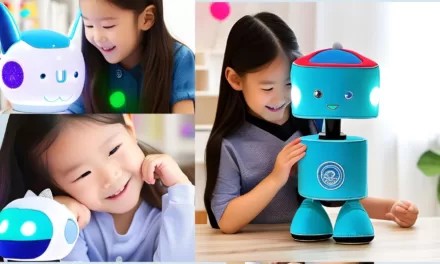Innovate, Educate, Automate: An Introduction to the Future of Robotics in Education!
The impact of robotics in education cannot be overstated. As we stand on the cusp of technological advancements, the integration of robotics into educational settings holds immense promise.
Robotics has the potential to revolutionize the way we teach and learn, opening doors to a future where students are engaged, empowered, and equipped with essential skills for the 21st century.
This article explores the current state of robotics in education and delves into the exciting possibilities it offers for the future.

Benefits of Robotics in Education:
Enhancing student engagement and motivation:
Active learning through hands-on experiences allows students to become active participants in the educational process. By interacting with robots, they can explore and experiment, fostering curiosity and a deep passion for learning.
Again, Personalized and interactive learning environments cater to individual student needs, creating an engaging and dynamic classroom atmosphere.
Fostering critical thinking and problem-solving skills:
Since Robotics challenges students to think critically and solve real-world problems. By designing and programming robots to tackle specific tasks, students develop logical reasoning, analytical thinking, and problem-solving skills.
Moreover, robotics encourages collaboration and teamwork as students work together to overcome challenges and achieve shared goals.
Bridging the gap between theory and practice:
Similarly, Robotics provides a bridge between theoretical knowledge and practical application. Students can apply the concepts they learn in subjects like science, technology, engineering, and mathematics (STEM) to build and program robots.
Therefore, this hands-on experience deepens their understanding of theoretical concepts, enhances retention, and nurtures practical skills and competence.
Cultivating creativity and innovation:
Besides, Robotics empowers students to unleash their creativity and become innovators. By designing and constructing their own robotic solutions, students engage in the iterative process of trial and error, promoting innovative thinking and problem-solving.
Additionally, the exploration of robotics nurtures an entrepreneurial mindset, fostering a spirit of initiative and resilience.
Current Applications of Robotics in Education:
Robotics in STEM education:
However, Robotics has become an integral part of STEM education, where it serves as a catalyst for learning science, technology, engineering, and mathematics. Robotics kits and platforms like LEGO Mindstorms and VEX Robotics are widely used in schools to introduce students to the principles of engineering, coding, and robotics.
Robotics in programming and coding education:
Again, Robotics offers a tangible and interactive medium for teaching programming and coding. Students learn coding concepts by programming robots to perform specific tasks, honing their computational thinking skills. Introduction to coding languages specifically designed for robotics, such as Python or Blockly, equips students with valuable skills for the digital age.
Robotics in special education:
On the other hand, Robotics has shown tremendous potential in special education settings. Educational robots provide support and assistance to students with special needs, promoting engagement and inclusive learning environments. Robots can assist in communication development, sensory integration, and social skills training, offering personalized learning experiences for students with diverse learning abilities.
Emerging Trends and Technologies in Robotics for Education:
Artificial Intelligence and machine learning in Robotics:
Moreover, the integration of artificial intelligence (AI) capabilities in educational robots is a game-changer. AI-powered robots can adapt to individual student needs, providing personalized learning experiences. Machine learning algorithms allow robots to analyze student performance data, identify areas of improvement, and adjust teaching strategies accordingly, enhancing the effectiveness of education.
Virtual and augmented reality in robotics education:
Meanwhile, Virtual and augmented reality technologies are being harnessed to simulate realistic scenarios in robotics education. Students can immerse themselves in virtual environments to practice robot programming or experiment with complex tasks without the need for physical equipment. Virtual robot programming interfaces and simulations offer safe and cost-effective ways to explore robotics concepts.
Social and emotional robotics:
Similarly, Social and emotional robotics focuses on the interaction between humans and robots, emphasizing emotional well-being and social skill development. Robots can serve as companions and facilitators, providing emotional support to students. Human-robot interaction fosters the development of empathy, social skills, and emotional intelligence, making education a holistic and enriching experience.
Implications and Challenges of Robotics in Education:
Ethical Considerations and responsible use of Robotics in Classrooms:
As robotics becomes more prevalent in education, ethical considerations arise. Privacy and data security concerns need to be addressed, ensuring the responsible collection and use of student data.
Additionally, equitable access to robotics education must be ensured, bridging the digital divide and avoiding further inequalities in education.
Teacher training and support for integrating robotics in the curriculum:
Educators play a crucial role in harnessing the potential of robotics in education. They require adequate training and ongoing support to effectively integrate robotics into the curriculum.
Again, the Professional development opportunities, collaborative networks, and resources for sharing best practices can empower teachers to embrace robotics as an innovative teaching tool.
Cost and accessibility of robotics technologies:
While the cost of robotics technologies can be a barrier to implementation in many educational settings. Efforts should be made to explore strategies that make robotics education more affordable, such as partnerships with industry or the development of low-cost robotic platforms.
By way of contrast, ensuring equal opportunities for all students, regardless of financial constraints, is essential for a future where robotics education is accessible to all.
Conclusion:
The future of robotics in education holds tremendous promise. The benefits of robotics, such as enhanced student engagement, critical thinking development, and bridging the gap between theory and practice, make it an invaluable tool for educators.
Afterward, as emerging trends and technologies, including AI, virtual reality, and social robotics, shape the landscape of robotics in education, it is imperative to consider the ethical implications and challenges that arise.
Therefore, through collaboration, responsible implementation, and a focus on accessibility, we can harness the transformative power of robotics to shape a future where education is dynamic, inclusive, and empowering.


